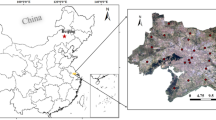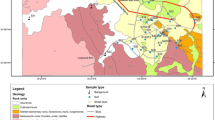Abstract
Toxic pollutants are affecting the environment on a global scale. To quantify the extent of the elemental pollution in Peixian, a typical Chinese city, we collected 332 soil samples from agricultural, residential, woodland, and hydrological environments. Using multivariate statistical and geostatistical analyses, the results indicate that contaminants including chromium (Cr), zinc (Zn), copper (Cu), lead (Pb), cadmium (Cd), and arsenic (As) may share common sources such as commercial activities, coal mining activities, water transportation, power generation, and livestock manure. The presence of mercury (Hg) in the southern part of the study area, however, is almost entirely attributed to nearby mining activities. The value of contamination index was the highest in hydrological environments. Health exposure risk assessments of the elements were also investigated. With the exception of Pb, the potentially toxic elements in the study area do not pose a severe non-carcinogenic health risk. At the levels observed in our study, however, Pb may pose a non-carcinogenic risk to children. Based on these results, the area’s livability is assessed. The urban livability analysis shows that the livability level is higher in the western part of the study area than it is in the eastern part.




Similar content being viewed by others
References
Argyraki A, Kelepertzis E, Botsou F, Paraskevopoulou V, Katsikis I, Trigoni M (2018) Environmental availability of trace elements (Pb, cd, Zn, cu) in soil from urban, suburban, rural and mining areas of Attica, Hellas. J Geochem Explor 187:201–213
Badland H, Whitzman C, Lowe M, Davern M, Aye L, Butterworth I, Hes D, Giles-Corti B (2014) Urban liveability: emerging lessons from Australia for exploring the potential for indicators to measure the social determinants of health. Soc Sci Med 111:64–73
Cai LM, Xu ZC, Bao P, He M, Dou L, Chen LG, Zhou YZ, Zhu YG (2015) Multivariate and geostatistical analyses of the spatial distribution and source of arsenic and heavy metals in the agricultural soils in Shunde, Southeast China. J Geochem Explor 148:189–195
Cao SZ, Duan XL, Zhao XG, Ma J, Dong T, Huang N, Sun CY, He B, Wei FS (2014) Health risks from the exposure of children to as, se, Pb and other heavy metals near the largest coking plant in China. Sci Total Environ 472:1001–1009
Cao YL, Wang X, Yin CQ, Xu WW, Shi W, Qian GR, Xun ZM (2018) Inland vessels emission inventory and the emission characteristics of the Beijing-Hangzhou Grand Canal in Jiangsu province. Process Saf Environ Prot 113:498–506
Chabukdhara M, Nema AK (2013) Heavy metals assessment in urban soil around industrial clusters in Ghaziabad, India: probabilistic health risk approach. Ecotoxicol Environ Saf 87:57–64
China (1995) Environmental Quality Standard for Soils
Demirak A, Yilmaz F, Tuna AL, Ozdemir N (2006) Heavy metals in water, sediment and tissues of Leuciscus cephalus from a stream in southwestern Turkey. Chemosphere 63:1451–1458
Dos Santos NM, do Nascimento CWA, Matschullat Jr, de Olinda RA (2017) Assessment of the spatial distribution of metal(Oid) s in soils around an abandoned Pb-smelter plant. Environ Manag 59:522–530
Engstrom DR, Fitzgerald WF, Cooke CA, Lamborg CH, Drevnick PE, Swain EB, Balogh SJ, Balcom PH (2014) Atmospheric hg emissions from preindustrial gold and silver extraction in the Americas: a reevaluation from lake-sediment archives. Environ Sci Technol 48:6533–6543
Gray MA (1990) The United Nations environment Programme: an assessment. Envtl L 20:291
Habitat U (2004) The state of the World’s cities. Globalization and Urban Culture. Earthscan, London
Han YM, Xuan DP, Ji CJ, Posmentier ES (2016) Multivariate analysis of heavy metal contamination in urban dusts of xi’an, Central China. Sci Total Environ 355:176–186
Hani A, Pazira E (2011) Heavy metals assessment and identification of their sources in agricultural soils of southern Tehran, Iran. Environ Monit Assess 176:677–691
He J, Yang Y, Christakos G, Liu Y, Yang X (2019) Assessment of soil heavy metal pollution using stochastic site indicators. Geoderma 337:359–367
Hou QY, Yang ZF, Ji JF, Yu T, Chen GG, Li J, Xia XQ, Zhang M, Yuan XY (2014) Annual net input fluxes of heavy metals of the agro-ecosystem in the Yangtze River delta, China. J Geochem Explor 139:68–84
Huang B, Li ZW, Li DQ, Yuan ZJ, Chen ZL, Huang JQ (2017) Distribution characteristics of heavy metal (loid) s in aggregates of different size fractions along contaminated paddy soil profile. Environ Sci Pollut R 24:23939–23952
Islam MS, Hossain MB, Matin A, Sarker MSI (2018) Assessment of heavy metal pollution, distribution and source apportionment in the sediment from Feni River estuary, Bangladesh. Chemosphere 202:25–32
Khan S, Cao Q, Zheng Y, Huang Y, Zhu Y (2008) Health risks of heavy metals in contaminated soils and food crops irrigated with wastewater in Beijing, China. Environ Pollut 152:686–692
Lee CS, Li XD, Shi WZ, Cheung SC, Thornton I (2006) Metal contamination in urban, suburban, and country park soils of Hong Kong: a study based on GIS and multivariate statistics. Sci Total Environ 356:45–61
Li JJ, Zhou XM, Yan JX, Li HJ, He JZ (2015) Effects of regenerating vegetation on soil enzyme activity and microbial structure in reclaimed soils on a surface coal mine site. Appl Soil Ecol 87:56–62
Liao QL, Liu C, Xu Y, Jin Y, Wu YZ, Hua M, Wan ZB, Weng ZH (2011) Geochemical baseline values of elements in soil of Jiangsu Province. Geol China 38:1363–1378
Liu XX, Wang YJ, Yan SY (2018) Interferometric SAR time series analysis for ground subsidence of the abandoned mining area in north Peixian using sentinel-1A TOPS data. J Indian Soc Remote 46:451–461
Loska K, Wiechuła D, Korus I (2004) Metal contamination of farming soils affected by industry. Environ Int 30:159–165
Lu L, Fan H, Liu J, Liu J, Yin J (2019) Time series mining subsidence monitoring with temporarily coherent points interferometry synthetic aperture radar: a case study in Peixian, China. Environ Earth Sci 78:461
Madrid L, Diaz-Barrientos E, Madrid F (2002) Distribution of heavy metal contents of urban soils in parks of Seville. Chemosphere 49:1301–1308
Mondal P, de Alcântara MR, Jonathan M, Biswas JK, Murugan K, Sarkar SK (2018) Seasonal assessment of trace element contamination in intertidal sediments of the meso-macrotidal Hooghly (Ganges) river estuary with a note on mercury speciation. Mar Pollut Bull 127:117–130
Muller G (1969) Index of geoaccumulation in sediments of the Rhine River. Geojournal 2:108–118
Müller G (1981) Sedimente als Kriterien der Wassergüte: Die Schwermetallbelastung der Sedimente des Neckars und seiner Nebenflüsse. Umschau 81:455–459
Pareja Carrera J, Mateo R, Rodríguez Estival J (2014) Lead (Pb) in sheep exposed to mining pollution: implications for animal and human health. Ecotoxicol Environ Saf 108:210–216
Peng H, Chen YL, Weng LP, Ma J, Ma YL, Li YT, Islam MS (2019) Comparisons of heavy metal input inventory in agricultural soils in north and South China: a review. Sci Total Environ 660:776–786
Rai PK, Lee SS, Zhang M, Tsang YF, Kim K-H (2019) Heavy metals in food crops: health risks, fate, mechanisms, and management. Environ Int 125:365–385
Singh M, Thind PS, John S (2018) Health risk assessment of the workers exposed to the heavy metals in e-waste recycling sites of Chandigarh and Ludhiana, Punjab, India. Chemosphere 203:426–433
State Environmental Protection Agency of China S (1995): Environmental Quality Standard for Soils
Tang Q, Liu GJ, Zhou CC, Zhang H, Sun RY (2013) Distribution of environmentally sensitive elements in residential soils near a coal-fired power plant: potential risks to ecology and children’s health. Chemosphere 93:2473–2479
Tavares M, Sousa A, Abreu M (2008) Ordinary kriging and indicator kriging in the cartography of trace elements contamination in São Domingos mining site (Alentejo, Portugal). J Geochem Explor 98:43–56
Tepanosyan G, Sahakyan L, Belyaeva O, Asmaryan S, Saghatelyan A (2018) Continuous impact of mining activities on soil heavy metals levels and human health. Sci Total Environ 639:900–909
Vatalis KI, Kaliampakos DC (2006) An overall index of environmental quality in coal mining areas and energy facilities. Environ Manag 38:1031–1045
Wang ZQ, Hong C, Xing Y, Wang K, Li YF, Feng LH, Ma SL (2018) Spatial distribution and sources of heavy metals in natural pasture soil around copper-molybdenum mine in Northeast China. Ecotoxicol Environ Saf 154:329–336
Xiao R, Zhang MX, Yao XY, Ma ZW, Yu FH, Bai JH (2016) Heavy metal distribution in different soil aggregate size classes from restored brackish marsh, oil exploitation zone, and tidal mud flat of the Yellow River Delta. J Soils Sediments 16:821–830
Yang XY, Ho P (2019) Is mining harmful or beneficial? A survey of local community perspectives in China. The Extractive Industries and Society
Yang XY, Zhao H, Ho P (2017) Mining-induced displacement and resettlement in China: a study covering 27 villages in 6 provinces. Res Policy 53:408–418
Yeomans JC, Bremner JM (1988) A rapid and precise method for routine determination of organic carbon in soil. Commun Soil Sci Plant Anal 19:1467–1476
Zahra A, Hashmi MZ, Malik RN, Ahmed Z (2014) Enrichment and geo-accumulation of heavy metals and risk assessment of sediments of the Kurang Nallah—feeding tributary of the Rawal Lake reservoir, Pakistan. Sci Total Environ 470:925–933
Zhang GL, Bai JH, Xiao R, Zhao QC, Jia J, Cui BS, Liu XH (2017) Heavy metal fractions and ecological risk assessment in sediments from urban, rural and reclamation-affected rivers of the Pearl River estuary, China. Chemosphere 184:278–288
Zhang PY, Qin CZ, Hong X, Kang GH, Qin MZ, Yang D, Pang B, Li YY, He JJ, Dick RP (2018) Risk assessment and source analysis of soil heavy metal pollution from lower reaches of Yellow River irrigation in China. Sci Total Environ 633:1136–1147
Zhao J, Dong Y, Xie XB, Li X, Zhang XX, Shen X (2011) Effect of annual variation in soil pH on available soil nutrients in pear orchards. Acta Ecol Sin 31:212–216
Zhou LL, Yang B, Xue ND, Li FS, Seip HM, Cong X, Yan YZ, Liu B, Han BL, Li HY (2014) Ecological risks and potential sources of heavy metals in agricultural soils from Huanghuai plain, China. Environ Sci Pollut R 21:1360–1369
Zhuang W, Liu YX, Chen Q, Wang Q, Zhou FX (2016) A new index for assessing heavy metal contamination in sediments of the Beijing-Hangzhou Grand Canal (Zaozhuang segment): a case study. Ecol Indic 69:252–260
Żukowska J, Biziuk M (2008) Methodological evaluation of method for dietary heavy metal intake. J Food Sci 73:21–29
Funding
This study was supported by the Open Research Fund of Jiangsu Key Laboratory of Resources and Environmental Information Engineering, CUMT (grant number JS201801), research on the technologies for controlling land and water resources in the Huang-Huai-Hai coal mining subsidence area under the Ministry of Natural Resources of the People’s Republic of China (grant number 2018-01-34), and the Fundamental Research Funds for the Central Universities (grant number 2017XKZD14). We thank Accdon (www.accdon.com) for its linguistic assistance during the preparation of this manuscript.
Author information
Authors and Affiliations
Corresponding author
Ethics declarations
Conflict of interest
The authors declare that they have no conflict of interest.
Ethical approval
The authors of this article did not perform any studies with human or animal participants.
Additional information
Responsible editor: Philippe Garrigues
Publisher’s note
Springer Nature remains neutral with regard to jurisdictional claims in published maps and institutional affiliations.
Electronic supplementary material
ESM 1
(DOCX 27 kb)
Rights and permissions
About this article
Cite this article
Tan, M., Zhao, H., Li, G. et al. Assessment of potentially toxic pollutants and urban livability in a typical resource-based city, China. Environ Sci Pollut Res 27, 18640–18649 (2020). https://doi.org/10.1007/s11356-020-08182-9
Received:
Accepted:
Published:
Issue Date:
DOI: https://doi.org/10.1007/s11356-020-08182-9




